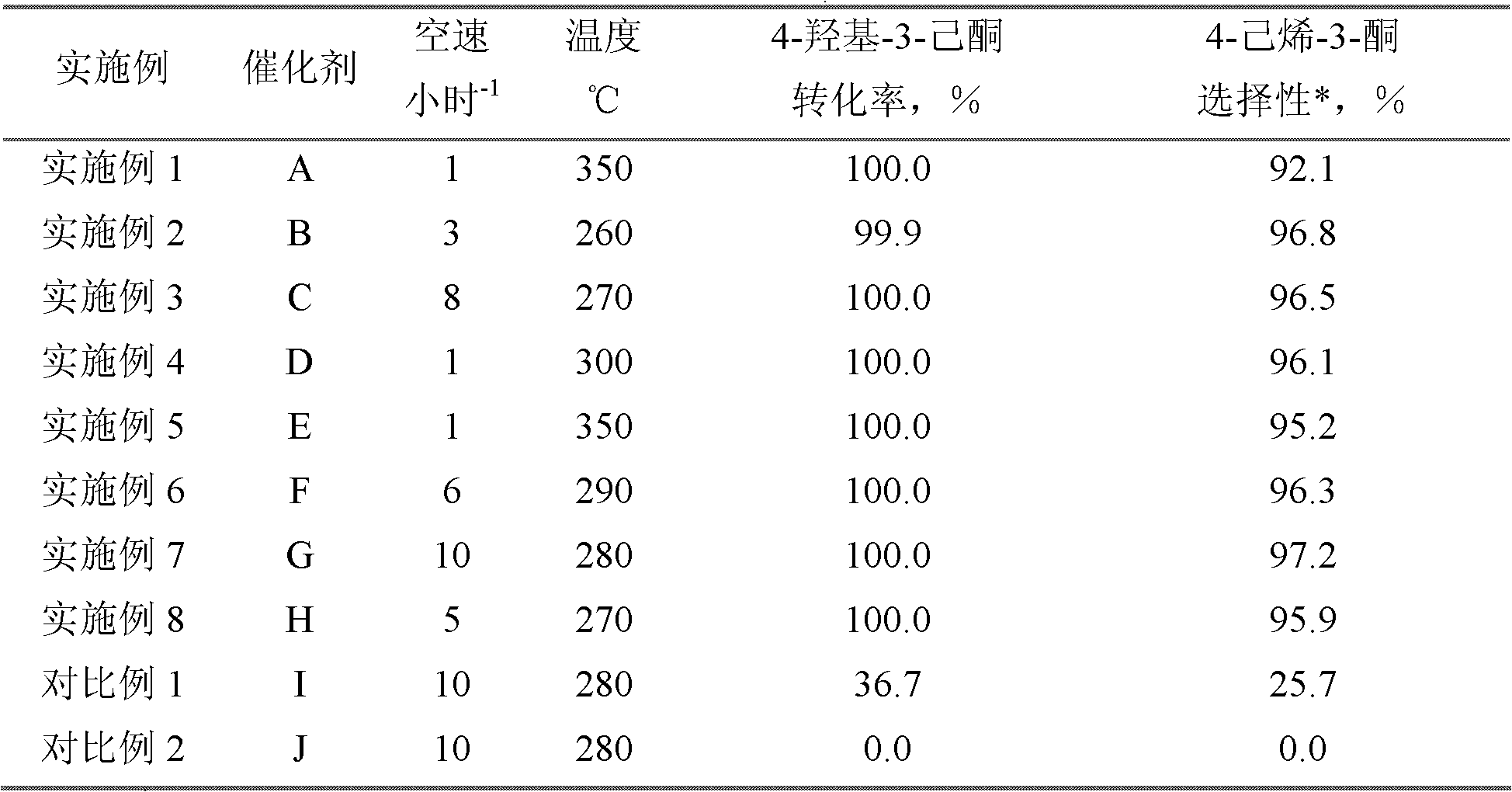Method for preparing 4-hexene-3-ketone by carrying out catalytic dehydration on 4-hydroxy-3-hexanone
A technology of catalytic dehydration and hexanone, applied in the preparation of carbon-based compounds, chemical instruments and methods, preparation of organic compounds, etc., can solve the problems of high reaction temperature, poor catalyst activity, low space velocity, etc., and achieve good technical effects. Effect
- Summary
- Abstract
- Description
- Claims
- Application Information
AI Technical Summary
Problems solved by technology
Method used
Image
Examples
Embodiment 1
[0018] Dissolve 30 grams of aluminum nitrate in 25 grams of deionized water, take 20 grams of MCM-41 carrier, impregnate the above solution at 20°C, take it out after 3 hours and dry it at 120°C for 5 hours, then bake it in a muffle furnace at 600°C for 4 hours. After cooling, it is taken out and then impregnated twice, dried and calcined to obtain catalyst A. Al in the catalyst 2 o 3 The parts by weight of the surface coating are 22.5 parts, and the parts by weight of MCM-41 are 77.5 parts. The performance evaluation of the catalyst was carried out on a fixed-bed reaction device at normal pressure. A stainless steel reactor with an inner diameter of 10 mm was used. The loading amount of the catalyst was 10 ml, the reaction temperature was 350 °C, and the liquid space velocity was 1 hour. -1 , reacted under normal pressure. The reaction product was analyzed by HP 6890 gas chromatography, hydrogen flame detector, and HP-6 capillary column (60m×0.25mm×0.25μm). The reaction r...
Embodiment 2
[0020] Dissolve 20 grams of aluminum sulfate in 100 grams of deionized water, take 20 grams of MCM-48 carrier, impregnate the above solution at 50°C, take it out after 4 hours and dry it at 100°C for 6 hours, then bake it in a muffle furnace at 500°C for 5 hours. After cooling, the catalyst B is obtained by taking it out, impregnating it twice, drying it, and roasting it. Al in the catalyst 2 o 3 The parts by weight of the surface coating are 25.2 parts, and the parts by weight of MCM-48 are 74.8 parts. Catalyst performance was evaluated according to the conditions of [Example 1], except that the reaction temperature was 260°C and the liquid space velocity was 3 hours -1 . The reaction results are shown in Table 1.
Embodiment 3
[0022] Dissolve 12 grams of aluminum nitrate in 20 grams of deionized water, take 15 grams of SBA-15 carrier, impregnate the above solution at 70°C, take it out after 2 hours and dry it at 110°C for 4 hours, then bake it in a muffle furnace at 650°C for 4 hours. Catalyst C is obtained. Al in the catalyst 2 o 3 The parts by weight of the surface coating are 13.0 parts by weight, and the parts by weight of SBA-15 are 87.0 parts by weight. Evaluation catalyst performance by the condition of [embodiment 1], just reaction temperature is 270 ℃, and liquid space velocity is 8 hours -1 . The reaction results are shown in Table 1.
PUM
 Login to View More
Login to View More Abstract
Description
Claims
Application Information
 Login to View More
Login to View More - Generate Ideas
- Intellectual Property
- Life Sciences
- Materials
- Tech Scout
- Unparalleled Data Quality
- Higher Quality Content
- 60% Fewer Hallucinations
Browse by: Latest US Patents, China's latest patents, Technical Efficacy Thesaurus, Application Domain, Technology Topic, Popular Technical Reports.
© 2025 PatSnap. All rights reserved.Legal|Privacy policy|Modern Slavery Act Transparency Statement|Sitemap|About US| Contact US: help@patsnap.com



